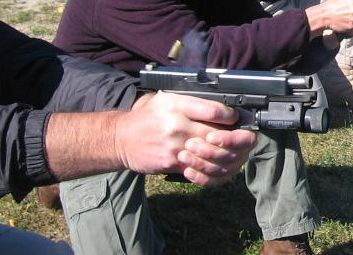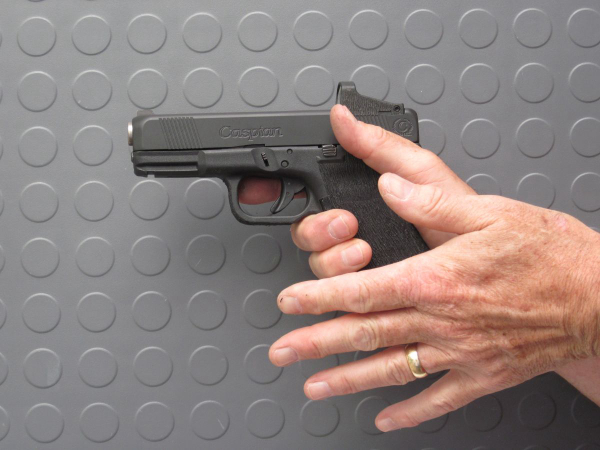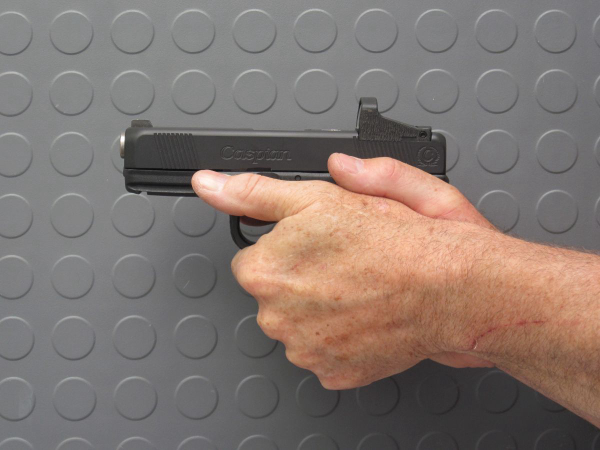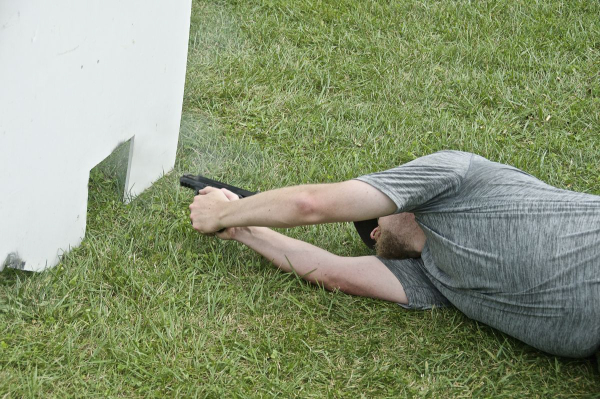Today’s feature is from correspondent Dave Spaulding.
I recently sat with several professional firearms instructors and listened to them debate the correct grip for the semi-automatic pistol. One advocated thumbs forward and another pushed for thumbs up. One even made the case for the thumbs being held away from the frame, so they wouldn’t apply undue pressure on the side of the gun, pushing the muzzle off target. I sat quietly and didn’t chime in. If I’m talking, I’m not listening, and it’s through listening that I learn. Also, I don’t really think the thumbs matter when it comes to applying a proper firing grip to a pistol.

What The Thumbs Do
Make a tight fist with your shooting hand and hold it. While retaining the fist, straighten the thumb forward and then up. Did the position of the thumb affect how tightly you could hold your fingers together? The truth is that the shooting hand applies pressure from front to back as if you’re squeezing a pair of pliers. The front and back straps of the pistol are what the shooting hand engages, leaving most of the side-to-side pressure to the support hand. This front-to-back pressure is both good and bad: It’s consistent with the rearward travel of the trigger, thus the index finger can efficiently apply pressure to the trigger face. This is the same reason that it’s bad. Because the hand is a sympathetic mechanism, it’s very hard to separate the trigger finger from the rest of the hand, and a convulsive grip of the entire hand as the trigger is being pressed will take the muzzle off target – which could cause us to miss our attacker completely, even at close range.
The support hand applies side-to-side pressure, as if it’s squeezing a rubber ball. The fingers are applying pressure toward the heel of the hand and, once again, the thumb doesn’t come into play. If the support hand is going to make maximum contact with the grip, the heel of the hand needs to make as much contact as possible with the available grip surface. Thus, it’s a good idea to keep this area open, allowing the support hand heel to be seated. This means that the shooting-hand thumb must be flagged or at least moved out of the way, which a thumbs-down grip can potentially interfere with.
If the thumb is locked down and the support hand attempts to apply inward pressure, the thumb can create a gap in the grip that provides recoil a travel path. The support hand then squeezes inward on the grip and shooting hand, creating a 360° wrap on the gun’s grip with inward pressure all around.
The 360° Wrap
Why is a 360° wrap on the pistol’s grip important? Because it helps keep the gun on target through the firing cycle and the recoil that results. How do you know if you have good recoil control? The gun returns where it started. Recoil actually travels backward, but the shooting hand applying forward pressure makes the muzzle rise as it seeks the path of least resistance.
By applying a continuous 360° wrap around the gun’s grip, which includes backward pressure to the gun’s front strap, upward pressure into the grip tang, and applying a forward lean by the upper body and arms into the gun, muzzle rise is greatly reduced or eliminated depending on the weapon being used. If a gap in the grip is evident, the gun will torque in that direction making it more difficult – slower -- to get back on target quickly for fast follow-up shots. Why are fast follow-up shots important? The possibility of a miss in addition to multiple shots are likely needed to create the level of incapacitation to stop a determined adversary quickly. The human body can be very difficult to incapacitate quickly.


How tight should the two hands be? Just apply as much pressure as you can and your shooting hand will compensate for the movement of the index finger. Focus on proper trigger control, and the rest will fall into place. Also consider the convulsive interaction of the hand as you try to depress the trigger as discussed previously. A tighter grip is much less likely to tighten and then loosen.
Are the thumbs important for combative shooting? I think so, but it has nothing to do with applying inward pressure. I like the thumbs forward, as they offer a secondary sighting device when trying to get the gun on target during the pandemonium of armed conflict. Many folks do not understand the importance of PLACING the gun on target, preferring to fling it to the target quickly. The thumbs also help apply greater pressure to the front strap and lock the wrists. Point your thumb at the wall and open your hand. Note how the fingers point down towards the floor? Place a pistol in this open hand and wrap the fingers around the grip. The fingers will apply rearward pressure to the front strap, camming the muzzle down and helping hold it in place. This applied pressure could come in handy when the gun fires.
Another Experiment
Take your empty primary hand, and hold it as if you’re gripping a pistol with your thumb straight forward. Separate your index finger, as if it were on the trigger face. Look at an item on the wall 15–30 feet away, and point your thumb at it, as if you were extending a pistol to shoot. Notice how the gun comes naturally into your eye/target line? The felt aspects of shooting are grossly under-rated!
What do I mean by this? All too often, shooting is made into a visual exercise with instructions such as, “look at the front sight before pressing the trigger” or “you won’t be able to see the front sight due to stress; you’ll focus on the threat.” The problem is that the eyes have nothing to do with shooting the gun. Shooting is a kinesthetic exercise and it should be thought of as such. All any sight system does it tell you where the muzzle is pointed, which is certainly required to fire an accurate shot. That said, at close range it is very possible to fire a combat effective shot by pointing the pistol in the direction of the target without sight confirmation. Again, the felt aspects of shooting are grossly under-rated.

We all point shoot even if we are sighted shooters. When does the front sight come into play when shooting a handgun? At the last moment before the trigger is pressed once the gun gets to the eye/target line. What got the gun to this point in the process? Physical manipulation that must be consistent and practiced so it can be accomplished without conscious thought. Would this not be a form of target focused or point shooting? Regardless of sight use or not, the gun must be PLACED on target.
Proper Body Manipulation
Does anyone really think they can thrust their pistol out in front of their body, chase down the front sight and get a quick and accurate shot by relying on the front sight alone? Even the father of front-sight focus, Jeff Cooper, stated, “The body aims, the sights confirm.” It’s practiced body movement and manipulation that gets the gun to the eye/target line quickly and accurately. By using the felt index of the thumbs-forward grip, the accuracy of this movement is merely enhanced. The word “proprioception” is used a lot these days. Body awareness is important when gripping and delivering a gun to the target.
Am I advocating point shooting? I don’t see a big difference between the two techniques. If a person practices using their front sight to confirm proper body manipulation and muzzle alignment when delivering their pistol to target, but then during the actual event they focus on the threat, does it really matter as long as the gun arrives where it’s needed? The truth is that it’s more likely that the shot will be missed due to improper trigger control than to sight alignment/picture. It is also wise to keep in mind it is VERY difficult to pull our eyes away from something that is trying to kill us.
In Sum
The handgun is controlled by two things: a proper grip applied to the pistol in a 360° full-contact fashion and the straight rearward travel of the trigger without the lower fingers trying to “help”. Sights are nice to confirm that the body did what it should’ve done, but they’re not essential in a close-quarters gunfight.
Should you use them if you can? Yes. But if you can’t, proper body motion will likely get them there for you if you’ve taken the time to note how it feels to properly deliver/place the gun on the target. Recreating that feel is worth practicing and, if front-sight focus/confirmation helps anchor this, then there’s no harm. Obtaining a proper grip on the gun, proper trigger control and forward body position are all kinesthetic exercises and must be practiced correctly. These are basic skills, essentials. Practice and prepare wisely.
— Dave Spaulding